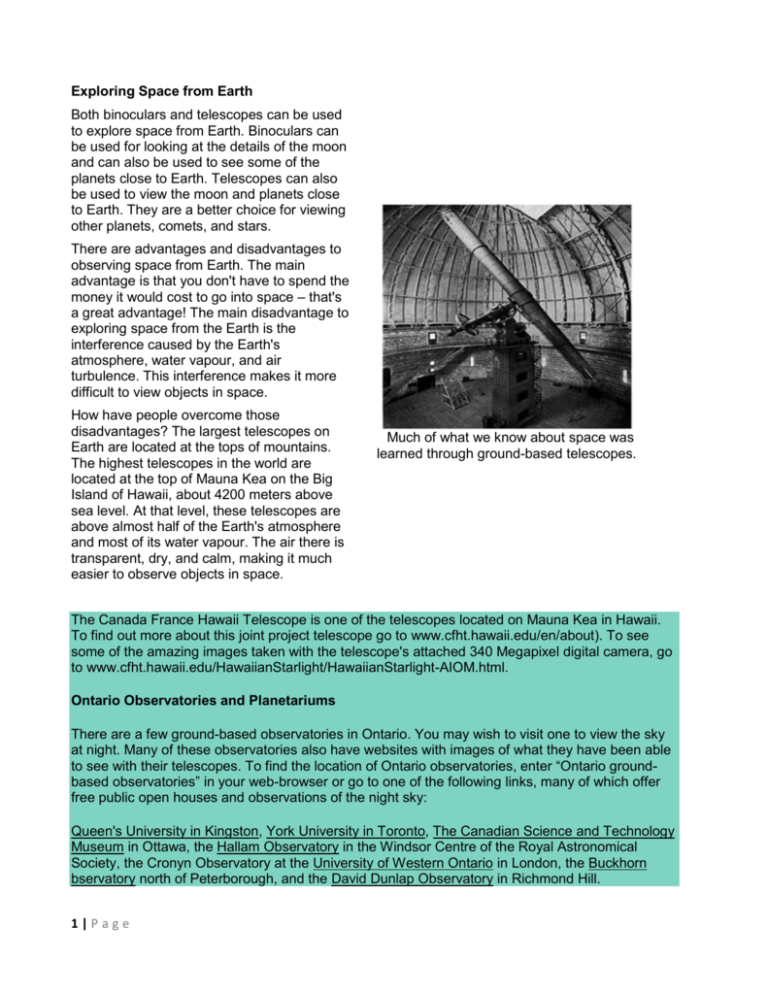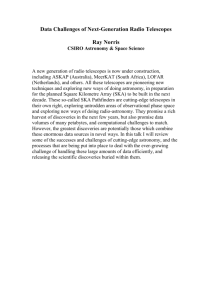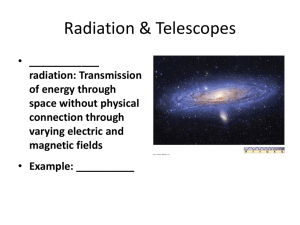In Canada, the Canadian Space Agency (CSA)
advertisement

Exploring Space from Earth Both binoculars and telescopes can be used to explore space from Earth. Binoculars can be used for looking at the details of the moon and can also be used to see some of the planets close to Earth. Telescopes can also be used to view the moon and planets close to Earth. They are a better choice for viewing other planets, comets, and stars. There are advantages and disadvantages to observing space from Earth. The main advantage is that you don't have to spend the money it would cost to go into space – that's a great advantage! The main disadvantage to exploring space from the Earth is the interference caused by the Earth's atmosphere, water vapour, and air turbulence. This interference makes it more difficult to view objects in space. How have people overcome those disadvantages? The largest telescopes on Earth are located at the tops of mountains. The highest telescopes in the world are located at the top of Mauna Kea on the Big Island of Hawaii, about 4200 meters above sea level. At that level, these telescopes are above almost half of the Earth's atmosphere and most of its water vapour. The air there is transparent, dry, and calm, making it much easier to observe objects in space. Much of what we know about space was learned through ground-based telescopes. The Canada France Hawaii Telescope is one of the telescopes located on Mauna Kea in Hawaii. To find out more about this joint project telescope go to www.cfht.hawaii.edu/en/about). To see some of the amazing images taken with the telescope's attached 340 Megapixel digital camera, go to www.cfht.hawaii.edu/HawaiianStarlight/HawaiianStarlight-AIOM.html. Ontario Observatories and Planetariums There are a few ground-based observatories in Ontario. You may wish to visit one to view the sky at night. Many of these observatories also have websites with images of what they have been able to see with their telescopes. To find the location of Ontario observatories, enter “Ontario groundbased observatories” in your web-browser or go to one of the following links, many of which offer free public open houses and observations of the night sky: Queen's University in Kingston, York University in Toronto, The Canadian Science and Technology Museum in Ottawa, the Hallam Observatory in the Windsor Centre of the Royal Astronomical Society, the Cronyn Observatory at the University of Western Ontario in London, the Buckhorn bservatory north of Peterborough, and the David Dunlap Observatory in Richmond Hill. 1|Page Famous People Don't underestimate your ability to be a space scientist if you only have a pair of binoculars or a small telescope. Galileo Galilei, a famous scientist who made important discoveries, used a simple telescope, and much what has been learned about our solar system was learned while looking through a telescope from Earth. Canadian Contribution Richard Bond, Canada's most famous astronomer, studies the structure of the universe. Courtesy of Virtual Museum of Canada. Exploring Space from Space Humans have found many ways to explore space from space. They have built space telescopes (e.g. the Hubble Telescope), walked on the moon, sent spaceships to look at the details of specific planets (e.g. the spaceship Galileo went to Jupiter), sent probes to collect data and perform experiments (e.g. the pioneer space probes) and built an International Space Station to learn more about space and its effects on humans living there. Just as there are advantages and disadvantages to exploring space from Earth, there are also advantages and disadvantages to exploring space from space. Canadian Contributions to Space Exploration In Canada, the Canadian Space Agency (CSA) directs Canada's involvement in space exploration. In the United States, the National Aeronautics and Space Administration (NASA) performs the same function. The websites for both of these organizations are trusted sources of information for the research you will do in this unit. Canada's various astronomical societies and university astronomy departments are also trusted sources of information. Dr. Roberta Bondar is one of many Canadian astronauts who have served on missions in space. Courtesy of The Canadian Space Agency. 2|Page





